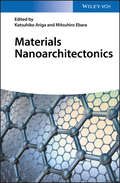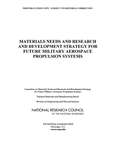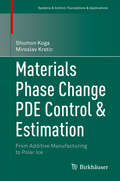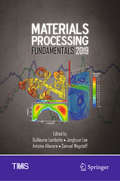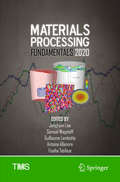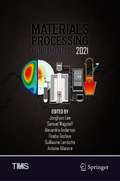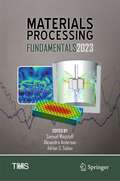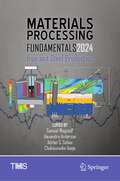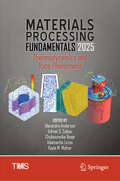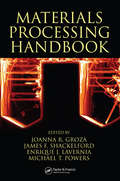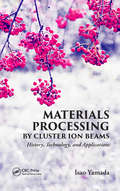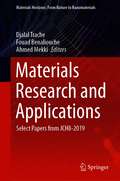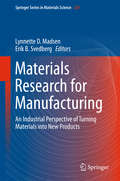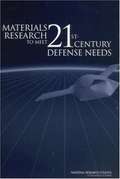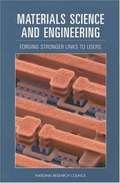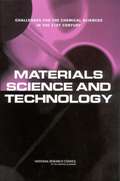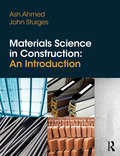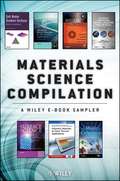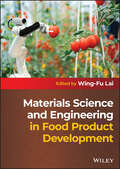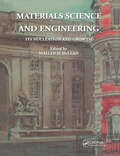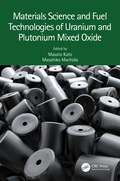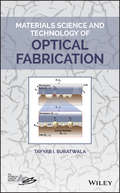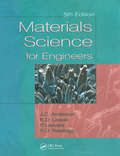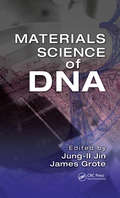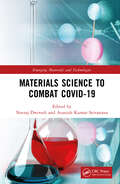- Table View
- List View
Materials Nanoarchitectonics
by Katsuhiko Ariga Mitsuhiro EbaraA unique overview of the manufacture of and applications for materials nanoarchitectonics, placing otherwise hard-to-find information in context. Edited by highly respected researchers from the most renowned materials science institute in Japan, the first part of this volume focuses on the fabrication and characterization of zero to three-dimensional nanomaterials, while the second part presents already existing as well as emerging applications in physics, chemistry, biology, and biomedicine.
Materials Needs and R&D Strategy for Future Military Aerospace Propulsion Systems
by National Research Council of the National AcademiesThe ongoing development of military aerospace platforms requires continuous technology advances in order to provide the nation's war fighters with the desired advantage. Significant advances in the performance and efficiency of jet and rocket propulsion systems are strongly dependent on the development of lighter more durable high-temperature materials. Materials development has been significantly reduced in the United States since the early 1990s, when the Department of Defense (DOD), the military services, and industry had very active materials development activities to underpin the development of new propulsion systems. This resulted in significant improvements in all engine characteristics and established the United States in global propulsion technology. Many of the significant advances in aircraft and rocket propulsion have been enabled by improved materials and, materials manufacturing processes. To improve efficiency further, engine weight must be reduced while preserving thrust. Materials Needs and Research and Development Strategy for Future Military Aerospace Propulsion Systems examines whether current and planned U.S. efforts are sufficient to meet U.S. military needs while keeping the U.S. on the leading edge of propulsion technology. This report considers mechanisms for the timely insertion of materials in propulsion systems and how these mechanisms might be improved, and describes the general elements of research and development strategies to develop materials for future military aerospace propulsion systems. The conclusions and recommendations asserted in this report will enhance the efficiency, level of effort, and impact of DOD materials development activities.
Materials Phase Change PDE Control & Estimation: From Additive Manufacturing to Polar Ice (Systems & Control: Foundations & Applications)
by Miroslav Krstic Shumon KogaThis monograph introduces breakthrough control algorithms for partial differential equation models with moving boundaries, the study of which is known as the Stefan problem. The algorithms can be used to improve the performance of various processes with phase changes, such as additive manufacturing. Using the authors' innovative design solutions, readers will also be equipped to apply estimation algorithms for real-world phase change dynamics, from polar ice to lithium-ion batteries.A historical treatment of the Stefan problem opens the book, situating readers in the larger context of the area. Following this, the chapters are organized into two parts. The first presents the design method and analysis of the boundary control and estimation algorithms. Part two then explores a number of applications, such as 3D printing via screw extrusion and laser sintering, and also discusses the experimental verifications conducted. A number of open problems and provided as well, offering readers multiple paths to explore in future research.Materials Phase Change PDE Control & Estimation is ideal for researchers and graduate students working on control and dynamical systems, and particularly those studying partial differential equations and moving boundaries. It will also appeal to industrial engineers and graduate students in engineering who are interested in this area.
Materials Processing Fundamentals 2019 (The Minerals, Metals & Materials Series)
by Jonghyun Lee Antoine Allanore Guillaume Lambotte Samuel WagstaffThis book includes contributions from the Materials Processing Fundamentals Symposium held at the TMS 2019 Annual Meeting & Exhibition in San Antonio, Texas. This volume includes contributions on the physical and numerical modeling of materials processing, and covers a range of metals and minerals. Authors present models and results related the basics of processing such as extraction, joining, separation, and casting. The corresponding fundamentals of mass and heat transport as well as physical and thermodynamics properties are addressed, allowing for a cross-disciplinary vision of the field.
Materials Processing Fundamentals 2020 (The Minerals, Metals & Materials Series)
by Jonghyun Lee Antoine Allanore Guillaume Lambotte Fiseha Tesfaye Samuel WagstaffThis volume includes contributions on the physical and numerical modeling of materials processing, and covers a range of metals and minerals. Authors present models and results related to the basics of processing such as extraction, joining, separation, and casting. The corresponding fundamentals of mass and heat transport as well as physical and thermodynamics properties are addressed, allowing for a cross-disciplinary vision of the field.
Materials Processing Fundamentals 2021 (The Minerals, Metals & Materials Series)
by Jonghyun Lee Antoine Allanore Guillaume Lambotte Fiseha Tesfaye Samuel Wagstaff Alexandra AndersonThis volume covers various aspects of the fundamentals, synthesis, analysis, design, monitoring, and control of metals, materials, and metallurgical processes and phenomena. Topics represented include but are not limited to: • Experimental, analytical, physical, and computer modeling of physical chemistry and thermodynamics • Modeling of the transport phenomena in materials processing and metallurgical processes involving iron, steel, nonferrous metals, and composites • Second-phase particles in metals and processes and the fundamentals (experimental studies or theoretical studies) on the nucleation, growth, motion, and removal of these particles from the molten metal or reactors • Physical chemistry, thermodynamics, and kinetics for the production and refining of rare-earth metals • Control of industrial processes in the field of extraction and processing of metals and materials
Materials Processing Fundamentals 2023 (The Minerals, Metals & Materials Series)
by Adrian S. Sabau Samuel Wagstaff Alexandra AndersonThis volume covers various aspects of the fundamentals, synthesis, analysis, design, monitoring, and control of metals, materials, and metallurgical processes and phenomena. Topics represented include but are not limited to:• Use of artificial intelligence or big data in the control or optimization of industrial processes • Modelling or optimization of recycle streams and scrap loops • Measurement and control in hostile environments • Modeling transport phenomena in materials processing and metallurgical processes involving iron, steel, nonferrous metals, and composites • Thermodynamics, kinetics, and physical chemistry of materials processes and modelling thereof
Materials Processing Fundamentals 2024: Iron and Steel Production (The Minerals, Metals & Materials Series)
by Adrian S. Sabau Samuel Wagstaff Alexandra Anderson Chukwunwike IloejeThis collection covers various aspects of the fundamentals, synthesis, analysis, design, monitoring, and control of metals, materials, and metallurgical processes and phenomena. This volume will focus on the fundamentals of iron and steel production including ladle processing, casting, rolling, forging, and subsequent surface treatments. Topics represented include, but are not limited to: • Use of artificial intelligence or big data in the control or optimization of industrial processes • Modelling or optimization of recycle streams and scrap loops • Measurement and control in hostile environments • Modeling transport phenomena in materials processing and metallurgical processes involving iron, steel, nonferrous metals, and composites • Thermodynamics, kinetics, and physical chemistry of materials processes and modelling thereof
Materials Processing Fundamentals 2025: Thermodynamics and Rate Phenomena (The Minerals, Metals & Materials Series)
by Adrian S. Sabau Alexandra Anderson Adamantia Lazou Chukwunwike Iloeje Kayla M. MolnarThis collection covers first principle and applied studies of thermodynamics and rate-governed phenomena including reaction kinetics and meso-, macro-scale transport of mass, momentum, and energy throughout the sequence of processing operations. Topics represented include but are not limited to: Thermodynamic modeling for the optimization of alloy solutions, slag compositions, and other types of materials Mass and energy balance simulations of material processing systems using software such as FactSage, MPE, HSC-SIM, and METSIM Experimental and numerical studies on kinetic rate theories pertaining to crucial material processes such as chemical reactions, diffusion, nucleation and phase transformations, and solidification Numerical modeling and simulation, such as computational fluid dynamics (CFD), of multi-scale transport phenomena in unit operations Development and application of process simulations that utilize a combination of thermodynamic, kinetic, and transport equations to simulate and/or control individual unit operations and/or plants
Materials Processing Handbook
by James F. Shackelford Enrique J. Lavernia Joanna R. Groza Michael T. PowersThe field of materials science and engineering is rapidly evolving into a science of its own. While traditional literature in this area often concentrates primarily on property and structure, the Materials Processing Handbook provides a much needed examination from the materials processing perspective. This unique focus reflects the changing comple
Materials Processing by Cluster Ion Beams: History, Technology, and Applications
by Isao YamadaMaterials Processing by Cluster Ion Beams: History, Technology, and Applications discusses the contemporary physics, materials science, surface engineering issues, and nanotechnology capabilities of cluster beam processing. Written by the originator of the gas cluster ion beam (GCIB) concept, this book:Offers an overview of ion beam technologies, f
Materials Research and Applications: Select Papers from JCH8-2019 (Materials Horizons: From Nature to Nanomaterials)
by Djalal Trache Fouad Benaliouche Ahmed MekkiThis highly informative and carefully presented book discusses the synthesis, processing, characterization and applications of different types of materials. It provides an overview of recent advances in the areas of materials research and engineering and highlights a wide range of significant recent results in energetic materials, bio-based materials, ceramics, nanomaterials, among others, and their use for emerging applications. The contents of this book are relevant to researchers in academia and industry professionals working on the development of advanced materials and their applications.
Materials Research for Manufacturing
by Lynnette D. Madsen Erik B. SvedbergThis book is about applied materials research in industry. It presents various important topics and challenges and gives guidance to materials researchers who move to industry. The book focuses on the materials manufacturing issues for industrial application. It deals with developments and challenges in traditional materials areas, such as metals and ceramics, and new opportunities that have risen from nanotechnology and additive manufacturing. The chapters, written by senior people from large companies, include successful manufacturing undertakings, several distinct and unresolved manufacturing challenges, with the focus on approaches, timelines and the skills needed for future company research and development. The book provides a cross-section of current and future approaches valuable for new employees and academics working in industry.
Materials Research to Meet 21st-century Defense Needs
by National Research CouncilIn order to achieve the revolutionary new defense capabilities offered by materials science and engineering, innovative management to reduce the risks associated with translating research results will be needed along with the R&D. While payoff is expected to be high from the promising areas of materials research, many of the benefits are likely to be evolutionary. Nevertheless, failure to invest in more speculative areas of research could lead to undesired technological surprises. Basic research in physics, chemistry, biology, and materials science will provide the seeds for potentially revolutionary technologies later in the 21st century.
Materials Science And Engineering: Forging Stronger Links To Users
by National Research CouncilMaterials are the foundation and fabric of manufactured products. In fact, many leading commercial products and military systems could not exist without advanced materials and many of the new products critical to the nation's continued prosperity will come only through the development and commercialization of new materials. Thus, the field of materials science and engineering (MS&E) affects quality of life, industrial competitiveness, and the global environment.The United States leads the world in materials research and development, but does not have as impressive a record in the commercialization of new materials. This book explores the relationships among the producers and users of materials and examines the processes of innovation--from the generation of knowledge to the ultimate integration of a material into a useful product. The authors recommend ways to accelerate the rate at which new ideas are integrated into finished products.Real-life case studies provide an accurate depiction of the processes that take materials and process innovations from the laboratory, to the factory floor, and ultimately to the consumer, drawing on experiences with three distinctive MS&E applications--advanced aircraft turbines, automobiles, and computer chips and information-storage devices.
Materials Science And Technology: Challenges For The Chemical Sciences In The 21st Century
by Manufacturing Organizing Committee For The Workshop On MaterialsThe report assesses the current state of chemistry and chemical engineering at the interface with materials science and identifies challenges for research. Recent advances are blurring the distinction between chemistry and materials science and are enabling the creation of new materials that, to date, have only been predicted by theory. These advances include a greater ability to construct materials from molecular components, to design materials for a desired function, to understand molecular "self-assembly, and to improve processes by which the material is "engineered" into the final product.
Materials Science In Construction: An Introduction
by Arshad Ahmed John SturgesMaterials Science in Construction explains the science behind the properties and behaviour of construction's most fundamental materials (metals, cement and concrete, polymers, timber, bricks and blocks, glass and plaster). In particular, the critical factors affecting in situ materials are examined, such as deterioration and the behaviour and durability of materials under performance. An accessible, easy-to-follow approach makes this book ideal for all diploma and undergraduate students on construction-related courses taking a module in construction materials.
Materials Science Reading Sampler
by WileyThe 2013 Materials Science eBook Sampler includes select material from seven Materials Science titles. Titles are from a number of Wiley imprints including Wiley, Wiley-VCH, Wiley-American Ceramic Society, Wiley-Scrivener and Wiley-The Minerals, Metals and Materials Society. The material that is included for each selection is the book's full Table of Contents as well as a sample chapter. If you would like to read more from these books, you can purchase the full book or e-book at your favorite online retailer.
Materials Science and Engineering in Food Product Development
by Wing-Fu LaiMaterials Science and Engineering in Food Product Development A comprehensive and accessible guide to the food development applications of cutting-edge materials science In Materials Science and Engineering in Food Product Development, distinguished researcher Wing-Fu Lai delivers an authoritative exploration of the roles played by materials science and engineering in food product development. In the book, the authors employ a practical, industrial perspective to illustrate how food products, especially functional foods, can benefit from the incorporation of materials science technologies. The book includes helpful glossary sections in each chapter, as well as important notes to highlight information useful to food manufacturers engaged in the real-world development and manufacture of foods. This book is appropriate for both early and advanced researchers interested in the design, improvement, and engineering of food products using the most current advances in food materials science. Readers will also find: A thorough overview of the most critical advances in food materials science Comprehensive explorations of a materials science approach to food product design and discussions of techniques for the characterization of food materials and products Practical discussions of the design and use of hydrogels, polymers, and lipid-based systems for food component encapsulation Comprehensive treatments of the optimization of pasting and textural properties of food products by rheological manipulation Perfect for students, researchers, and scholars in the fields of nutritional science, materials engineering, food science, food engineering, and nanotechnology, Materials Science and Engineering in Food Product Development will also benefit food manufacturing professionals during food product development.
Materials Science and Engineering: Its Nucleation and Growth
by Malcolm McLeanThis book is a record of the conference entitled Materials Science and Engineering: Its Nucleation and Growth held at Imperial College on 14 and 15 May 2001 as one of the events held to mark the 150th Anniversary of the founding of the Royal School of Mines (RSM).
Materials Science and Fuel Technologies of Uranium and Plutonium Mixed Oxide
by Masato Kato Masahiko MachidaMaterials Science and Fuel Technologies of Uranium and Plutonium Mixed Oxide offers a deep understanding of MOX properties for nuclear fuels that will be useful for performance evaluation. It also reviews fuel property simulation technology and an irradiation behavior model required for performance evaluation. Based on research findings, the book investigates various physical property data in order to develop MOX fuel for sodium-cooled fast reactors. It discusses a database of MOX properties, including oxygen potential, melting temperature, the lattice parameter, sound speeds, thermal expansion, thermal diffusivity, oxygen self-diffusion, and chemical diffusion coefficients, that was used to derive a science-based model of MOX properties (Sci-M Pro) for fuel-performance code development. Features: Concisely covers the essential aspects of MOX nuclear fuels. Explores MOX nuclear fuels by systematically evaluating various physical property values using a behavior model. Presents fuel property simulation technology. Considers oxygen potential, the lattice parameter, sound speeds, and oxygen self-diffusion. Discusses melting temperature, thermal expansion, thermal diffusivity, and chemical diffusion coefficients. The book will be useful for researchers and engineers working in the field of nuclear fuels and nuclear materials.
Materials Science and Technology of Optical Fabrication
by Tayyab I. SuratwalaCovers the fundamental science of grinding and polishing by examining the chemical and mechanical interactions over many scale lengths Manufacturing next generation optics has been, and will continue to be, enablers for enhancing the performance of advanced laser, imaging, and spectroscopy systems. This book reexamines the age-old field of optical fabrication from a materials-science perspective, specifically the multiple, complex interactions between the workpiece (optic), slurry, and lap. It also describes novel characterization and fabrication techniques to improve and better understand the optical fabrication process, ultimately leading to higher quality optics with higher yield. Materials Science and Technology of Optical Fabrication is divided into two major parts. The first part describes the phenomena and corresponding process parameters affecting both the grinding and polishing processes during optical fabrication. It then relates them to the critical resulting properties of the optic (surface quality, surface figure, surface roughness, and material removal rate). The second part of the book covers a number of related topics including: developed forensic tools used to increase yield of optics with respect to surface quality (scratch/dig) and fracture loss; novel characterization and fabrication techniques used to understand/quantify the fundamental phenomena described in the first part of the book; novel and recent optical fabrication processes and their connection with the fundamental interactions; and finally, special techniques utilized to fabricate optics with high damage resistance. Focuses on the fundamentals of grinding and polishing, from a materials science viewpoint, by studying the chemical and mechanical interactions/phenomena over many scale lengths between the workpiece, slurry, and lap Explains how these phenomena affect the major characteristics of the optic workpiece—namely surface figure, surface quality, surface roughness, and material removal rate Describes methods to improve the major characteristics of the workpiece as well as improve process yield, such as through fractography and scratch forensics Covers novel characterization and fabrication techniques used to understand and quantify the fundamental phenomena of various aspects of the workpiece or fabrication process Details novel and recent optical fabrication processes and their connection with the fundamental interactions Materials Science and Technology of Optical Fabrication is an excellent guidebook for process engineers, fabrication engineers, manufacturing engineers, optical scientists, and opticians in the optical fabrication industry. It will also be helpful for students studying material science and applied optics/photonics.
Materials Science for Engineers
by J.C. Anderson Keith D. Leaver Rees D. Rawlings Patrick S. LeeversThis fifth edition of a successful textbook continues to provide students with an introduction to the basic principles of materials science over a broad range of topics. The authors have revised and updated this edition to include many new applications and recently developed materials.The book is presented in three parts. The first section discusses the physics, chemistry, and internal structure of materials. The second part examines the mechanical properties of materials and their application in engineering situations. The final section presents the electromagnetic properties of materials and their application. Each chapter begins with an outline of the relevance of its topics and ends with problems that require an understanding of the theory and some reasoning ability to resolve. These are followed by self-assessment questions, which test students' understanding of the principles of materials science and are designed to quickly cover the subject area of the chapter.This edition of Materials Science for Engineers includes an expanded treatment of many materials, particulary polymers, foams, composites and functional materials. Of the latter, superconductors and magnetics have received greater coverage to account for the considerable development in these fields in recent years. New sections on liquid crystals, superalloys, and organic semiconductors have also been added to provide a comprehensive overview of the field of materials science.
Materials Science of DNA
by James Grote Jung-Ii JinThe field of materials science and technology has undergone revolutionary advances due to the development of novel analytical tools, functional materials, and multidisciplinary approaches to engineering. Additionally, theoretical predictions combined with increasingly improved models and computational capabilities are making impressive contribution
Materials Science to Combat COVID-19 (Emerging Materials and Technologies)
by Avanish Kumar Srivastava Neeraj DwivediThis book covers the application of emerging materials to combat coronavirus. It discusses various physicochemical and biomedical characteristics of 2D materials, such as graphene, MXenes, and their various other derivatives, followed by proposal of how such materials can be used to design and develop several systems capable of fighting infectious diseases like coronavirus. It also covers fundamental and product developments based on MXene and graphene-based materials using emerging 3D printing process and other pertinent aspects. Features: • Focusses on COVID-19 from cross-disciplinary approach, especially biophysical management of the virus. • Discusses emerging 2D materials such as MXene and graphene to combat coronavirus. • Reviews development of PPEs, sterilizers, foams, antimicrobial surfaces, biosensors from materials science perspective. • Explores pertinent fundamental mechanisms to develop structure・property relationships. • Examines cytotoxicity and biocompatibility of the discussed 2D materials. This book is aimed at researchers and graduate students in biotechnology, biomedical engineering, chemical engineering, and materials science.
